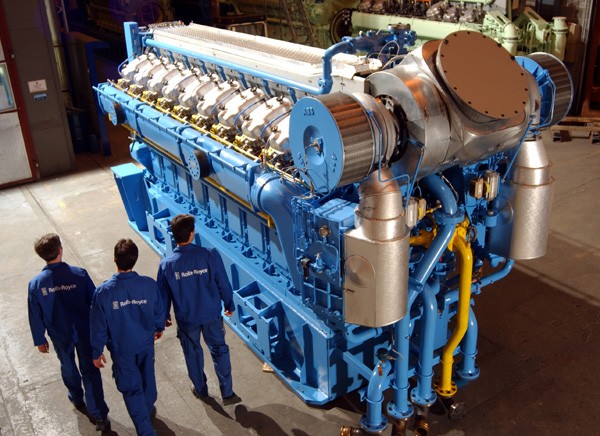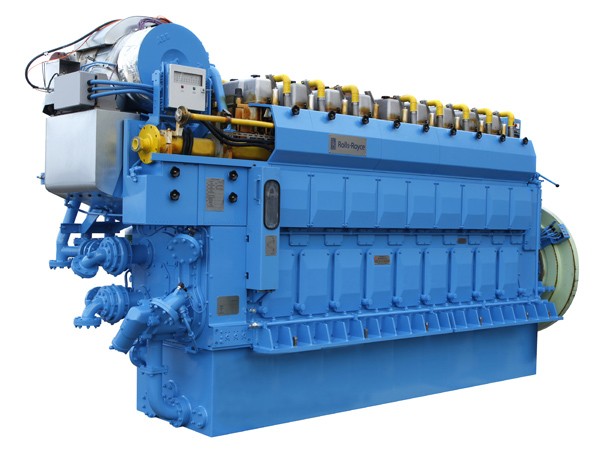Was The World’s ‘Northern-Most Island’ Erased From Charts?
by Kevin Hamilton (University of Hawaii) In 2021, an expedition off the icy northern Greenland coast spotted what appeared to be a previously uncharted island. It was small and gravelly,...


– By Rolls Royce Marine
Leading the way with gas engines for marine propulsion
Liquefied natural gas (LNG) is becoming a popular fuel for ships, with Rolls-Royce a leading manufacturer of engines for propulsion and electric power generation.
Originally the reason for adopting LNG instead of liquid fuel was to reduce emissions of NOx, sulphur oxides, and particulates (smoke/soot). An added benefit came from the chemical composition of methane, in the form of much reduced CO2 emissions. A negative feature of LNG fuel is that any gas which is not combusted is a highly potent greenhouse gas, with an effect that offsets the gain from reduced CO2.
Although various media have highlighted “methane slip” from marine engines, the contribution to total world greenhouse gas emissions is minute. Direct emission of methane from agriculture, mining, shale oil and gas production, industry and natural seepage is enormous by comparison.
Early marine gas engines from Rolls-Royce were the Bergen K-series. These were related to several hundred engines delivered for land power generation burning various types of fuel gas, including methane–rich landfill gas that would otherwise have escaped to add to greenhouse gas effect. This engine type had less methane slip than competing engines, but Rolls-Royce was aware of the desirability of further reducing methane slip, and so developed the C-series gas engines and the larger B-series in-line and BV-series V-engines based on the company’s lean-burn Otto cycle technology. Extremely close control of combustion in every cylinder at all times, design of the combustion chamber using the latest computer aided design tools, and optimised turbocharging, has cut methane slip to very low levels. These engines can either be used for generator drive in a gas engine/electric transmission or for driving the propeller through a mechanical transmission directly.
The greenhouse effect of methane is estimated differently by various government authorities and environmental organizations as between 21 and 25 times that of CO2 for the same quantity. Rolls-Royce uses a rather pessimistic figure of 23 in its calculations, and presents the engine emissions figure as the net reduction of CO2 emissions after accounting for the negative effect of the very low methane slip. For example, the reduction of CO2 itself in the gas engine compared with an engine running on distillate diesel or heavy fuel is up to 30%. Even after allowing for methane slip, the total GHG reduction is very great.
This means that the Rolls-Royce marine gas engine ranges fulfil the requirements for operation in Emission Control Areas (ECA) and the very strict IMO Tier III rules that come into force in 2016. Emissions of NOx are about 92% less than liquid fuel engines, SOx and particulates are negligible, and even after allowing for the effect of methane slip the total GHG emission is about 22% lower than a comparable diesel engine. The thermal efficiency of these engines is also very high, in the range 49-50.3% depending on the engine type. Other advantages of these gas engines include greatly reduced risk of oil spills, a cleaner engineroom, and the absence of smoke.


Currently Rolls-Royce Bergen gas engines are in service in, or on order for, ferries, roro vessels, tankers, coast guard ships and offshore support vessels. To date, 35 marine engines have been sold, and about 500 land engines, with cumulative running time of over 20 million running hours.
Following excellent experience with the LNG fueled engines in five double-ended ferries in intensive service connecting main road routes on the west coast of Norway, a second generation and larger ferry has now been delivered. Boknafjord can carry 242 cars or equivalent, and 589 passengers. Three Rolls-Royce C26:33 nine cylinder gas engines drive generators to power four of the company’s Azipull steerable thrusters to maximise the vessel’s efficiency and manoeuvrability.
Torghatten Nord, operating ferries in tough weather conditions in the north of Norway, is also going for gas. Four vessels now being built in Poland will be powered by lean burn Rolls-Royce gas engines with mechanical drive to the propellers.
Ferries are a testing environment for engines. “If you can survive the ferry cycle you can survive anything. The repeated heating up and cooling down puts a massive strain on the engines,” says Odd Magne Horgen, General Manager for Engine Sales in Rolls-Royce.


The world’s coastal and short sea vessel fleet is ageing, and alert operators are now ordering future orientated designs with LNG as the fuel. For its fleet renewal programme, Norlines has ordered 5,000dwt vessels of Rolls-Royce design to carry roro freight, containers and pallets on its North Sea/Baltic routes. The chosen power is a single B35:40L9 gas engine driving the controllable pitch propeller through a gearbox. Propeller and rudder are integrated hydrodynamically to give a very efficient and low emissions propulsion system.
Offshore service vessels can profit from changing to gas fuel, as well as reducing marine emissions. An example is Island Offshore, who are adding two platform supply vessels of Rolls-Royce UT 776 CDG design with C-series LNG fueled engines to their fleet.
Discussions are also in progress with a Japanese owner about the propulsion of a 70,000dwt bulk carrier using twin Bergen gas engines, taking LNG fuel and medium speed engines into this type of vessel.
As the LNG bunkering infrastructure expands this fuel becomes a realistic choice for commercial shipowners. The major classification societies now have rules for LNG fuelled vessels, and Rolls-Royce can engineer and supply gas engine installations, from the engine itself through the propulsion system to the design of the whole ship.
Join the gCaptain Club for curated content, insider opinions, and vibrant community discussions.


Join the 105,889 members that receive our newsletter.
Have a news tip? Let us know.
Access exclusive insights, engage in vibrant discussions, and gain perspectives from our CEO.
Sign Up




Maritime and offshore news trusted by our 105,889 members delivered daily straight to your inbox.



Essential news coupled with the finest maritime content sourced from across the globe.
Sign Up